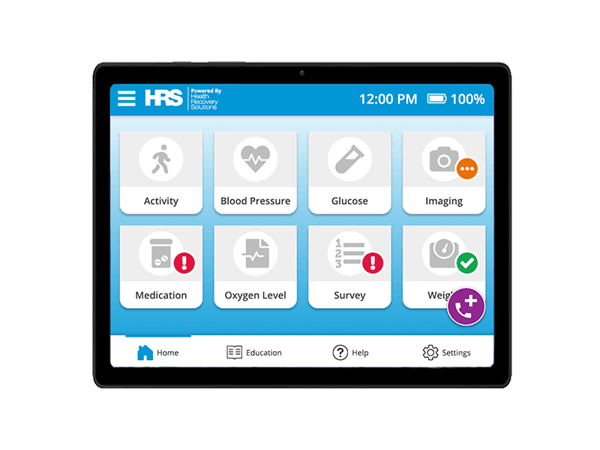Telehealth technology encompasses a wide range of tools and devices, including, but not limited to:
- Telemedicine technology for virtual visits and patient education, like iPads and mobile phones
- Bluetooth biometric devices, like pulse oximeters, glucometers, wearables, aFib devices and weight scales
For some people, being exposed to new technology can be intimidating. For any age, learning how to set up a device, connecting virtually, using the devices daily, and engaging with others through a virtual platform can be stressful. Today, we communicate virtually with loved ones, friends, colleagues, and now doctors through one click of a button.
Health Recovery Solutions (HRS) serves over 225,000 patients ranging from 3 months old to 103, with an average of 83-years old. HRS’ telehealth and remote patient solution is for patients of all ages, regardless of whether they’re new to telehealth or not.

How will l get my 89-year-old father to use a telehealth platform if he has never been exposed to technology?
Good news! Your father does not need to be a computer expert to use any of HRS’ 4 telehealth solutions. First, let’s use the example of PatientConnect Complete or PatientConnect Core. As soon as the device arrives at your father's door, all he needs to do is press “power”. Your father will then be directed through a series of prompts. The prompts are both audio and visual, so your father can easily navigate the device going step-by-step.
All devices are set to a 2nd grade reading level to make the process as simple as possible. If your father is using PatientConnect Mobile, all he has to do is download the application from the App store, and for PatientConnect Voice, there’s no set up at all.
Education is essential for telehealth program success. When a patient is exposed to telehealth technology for the first time they must be educated on the goal of the telehealth program and how they should interact with the technology.
Comprehensive education helps ensure the patient understands how the telehealth technology works and what their role is in engaging with the solution.
In a recent blog from the Carnegie Library of Pittsburgh, Dan East Liberty shares his “Tips for Helping Someone Learn to Use Technology” that are helpful when being exposed for the first time.
- Be patient
- Set goals and limits
- Watch your language
- Be even more patient
- Follow up
- Schedule a session
- Fight the urge to do it for them
- Use the phone or device
- Be realistic
How does HRS’ telehealth technology motivate and engage a patient for daily use?
Since each patient differs in age and condition, the telehealth devices suit each patient's needs in a unique way. It is up to the patient and clinician on how they want to utilize the HRS platform. Below, are two patient scenarios of patients with different circumstances:
Patient: Elizabeth
Age: 22
Condition: Post-Operation
- Using the wound imaging feature to track healing progression
- Utilizing the call feature to connect with nurses when concerns arise
Patient: Richard
Age: 64-years old
Condition: Type 1 Diabetes
- Utilizing Blueooth peripherals such as the glucometer and scale to provide real-time daily vital updates to his clinician
- Using educational content and quizzes based on disease state to increase health literacy and improve understanding of condition
- Getting medication reconciliation through reminders to increase medication adherence
 The HRS Tablet was built with a focus on ease-of-use for all patients.
The HRS Tablet was built with a focus on ease-of-use for all patients.
HRS Patient Success Stories
HRS clients are offering telehealth technology and RPM to patients with a diverse range of conditions. Every patient is unique, and is provided with a customized care plan tailored to their individual needs. Below, meet 3 patients, all with different conditions, who saw success with the HRS platform.
Meet Leon- A Home Health Patient with Chronic Systolic Heart Failure
Meet Marie- A Home Health Patient with CHF, End-stage Renal Disease, Degenerative Eyesight
Meet Francis- A Hospice Patient with Pain and Acute Symptom Management
Age is Not a Barrier
All patients, regardless of their age, should have the opportunity to access care via telehealth. To ensure this is possible, telehealth solutions must always have the patient top of mind. Ease of use is essential and education is crucial. As the COVID-19 pandemic continues, our population ages, and the telehealth industry continues to advance, more and more patients of all ages will turn to telehealth as a tool for convenient, quality care.

